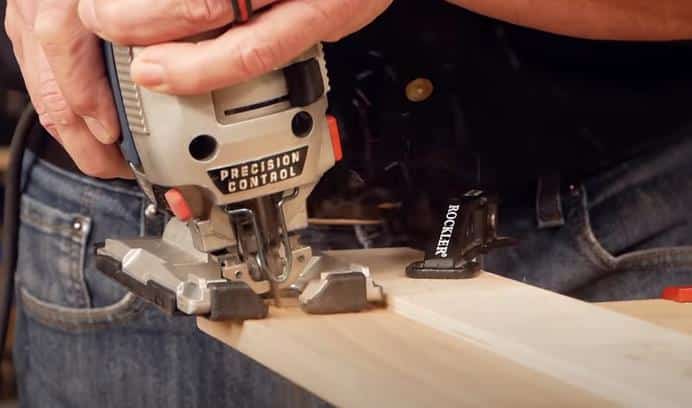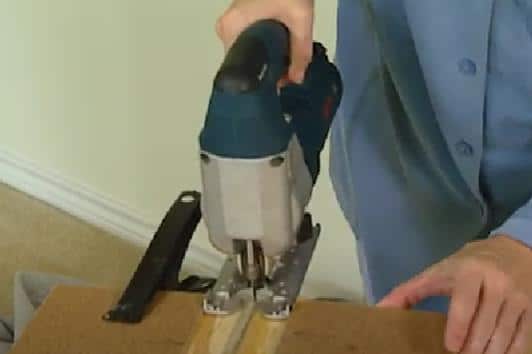Use a sharp blade and keep the jigsaw steady and level.
A jigsaw is a versatile tool that can be used to cut curves and intricate designs in a wide range of materials, such as wood, plastic, metal, and more. However, cutting straight lines is one of people’s biggest challenges when using a jigsaw.
Cutting straight with a jigsaw can be daunting, but it won’t be impossible. In this article, I will share some tips and techniques on how to cut straight with a jigsaw.
Following these right technique and some tips and tricks to help you cut straight with a jigsaw like a pro. Whether cutting wood, metal, or plastic, this guide will give you everything you need to know to make accurate, precise cuts every time.
So, get ready to take your jigsaw skills to the next level and confidently produce professional-looking results.
How To Cut Straight With A Jigsaw?

If you’re working with wood, there’s a good chance you’ll need to make a few cuts with a jigsaw. This can be a bit tricky, especially if you’re trying to get a straight cut.
Here is a step-by-step process on how to cut straight with a jigsaw:
Materials needed:
- Jigsaw
- Jigsaw blade suitable for the material you’re cutting
- Safety glasses
- Workbench or sawhorse
- Clamp
- Measuring tape or ruler
- Pencil or marker
Steps:
- First prepare your workspace. Set up your workbench or sawhorse in an area with good lighting and enough room to move around. Wear safety glasses to keep things from flying into your eyes.
- Choose the right blade for what you’re trying to cut. There are different kinds of jigsaw blades, like wood, metal, or plastic. Make sure you choose the right blade for what you’re cutting.
- Mark where you want to cut. Use a measuring tape or ruler to find the length of the line you want to cut, and then draw or write it on the material’s surface. Use a straight edge or a carpenter’s square to ensure the line is straight.
- Get hold of the stuff. Clamp the material to your workbench or sawhorse so it doesn’t move as you cut.
- Set the jigsaw’s pace. You may need to change the jigsaw’s speed depending on what you are cutting. Follow the instructions from the maker to change the speed if you need to.
- Line up the blade of the jigsaw with the cutting line. Place the jigsaw blade just to the side of the line you want to cut, and make sure it is perpendicular to the material’s surface.
- Turn on the jigsaw and cut the piece. Start the jigsaw and move the blade slowly along the cutting line. Cut with a steady hand and an even amount of pressure. Take breaks to rest your arms and hands when you need to.
- Complete the cut. When you reach the end of the cutting line, please turn off the jigsaw and carefully pull it out of the material if necessary. Use sandpaper to smooth any rough edges.
Following these steps, you can use a jigsaw to make straight cuts. Remember to take your time, be careful, and always wear the right safety gear when using power tools.
Some Essential Tips For Using A Jigsaw To Make Straight Cuts
Use a jigsaw with a guide to make straight cuts.

Here are some essential tips for using a jigsaw to make straight cuts:
Use a Guide:
Whether using a guide rail or a simple straight edge clamped to your workpiece, having a guide will help you make straighter cuts.
Select the Correct Blade:
The quality of your cut is determined by the blade you use. So use the right blade for the material. Different materials require different blades.
You can use a fine-toothed blade with a T-shank for straight cuts. The blade should be long adequately to cut through the material’s whole thickness.
And ensuring use a sharp blade. A dull blade will cause the jigsaw to wander, making it harder to keep a straight cut.
Mark Your Cut:
Mark the line you wish to cut with a straight edge or a ruler. Check that your line is visible and clear.
Secure Your Material:
Clamp your material to a workstation or a sawhorse to keep it from moving while you cut it. It ensures that your cut is straight and precise.
Adjust Your Jigsaw:
Make sure the blade guide is parallel to the blade. It will aid in keeping the blade straight during the cut. And use a steady hand. This may seem obvious, but it’s worth mentioning. Making a straight cut will be very difficult if you’re not holding the jigsaw steady.
Start Slow:
Begin slowly and gradually raise the speed of your jigsaw as you begin the cut. It will aid in maintaining control and accuracy.
Speeding through a cut is tempting, but going too fast will also cause the jigsaw to wander. Slow and steady is the way to go.
Follow Your Line:
- Please keep your eyes on the line and use the jigsaw blade to follow it.
- Do not attempt to drive the blade through the material.
- Allow the blade to do the work.
Complete the Cut:
After cutting through the material, turn off the jigsaw and wait for the blade to stop spinning before removing it from the cut. It will help to avoid any unintentional damage.
Making straight cuts with a jigsaw isn’t always easy, but with a little practice, it can be done. By using these tips, you can use your jigsaw to make straight cuts that look like they were done by a professional.
How Do You Ensure A Straight Cut With A Jigsaw?
You must use a straightedge guide to ensure a straight cut with a jigsaw.

If you’re looking for a clean, straight cut with a jigsaw, you can do a few things to ensure success.
First, use a sharp blade appropriate for the material you’re cutting. A dull blade will make getting a clean, straight cut more difficult.
Second, use a guide to help keep the blade on track. You can use a straight edge or a clamp-on guide.
Third, take your time and make sure each cut is slow and deliberate. Rushing through the cut will likely result in a less than perfect finish.
Let’s say you want to cut a piece of plywood down to size. First, you must select a good sharp blade for cutting wood. Next, you’ll need to set up a guide. If you’re using a straight edge, you’ll want to clamp it down so it doesn’t move while cutting.
If you’re using a clamp-on guide, attach it to the edge of the plywood. Then, it’s time to start cutting. Slowly guide the blade along the edge of the guide, keeping the blade on track. If the blade is veering off course, stop and realign it. Once you’ve finished the cut, you should have a nice, straight edge.
How Do You Keep A Jigsaw Blade From Wandering?
Use a guide.
What Are Some Ways To Hold A Workpiece While Cutting It With A Jigsaw?
There are many ways to hold a workpiece while cutting it with a jigsaw, but some common methods are to use a vise, clamps, or a hand-held saw guide.
The jigsaw is one of the most versatile tools in a woodworker’s arsenal. With its ability to make straight and curved cuts, the jigsaw is ideal for various projects.
But one of the challenges of using a jigsaw is holding the workpiece securely while cutting. If the workpiece isn’t properly secured, it can move around while you’re cutting, resulting in an inaccurate cut or even injury.
So, what are the best ways to hold a workpiece while cutting it with a jigsaw?
Here are a few options:
Clamps
One of the most common ways to hold a workpiece while cutting it with a jigsaw is to use clamps. Clamps come in various sizes and styles, so you can choose the ones that best suit your project.
Place clamps around the workpiece, making sure they are tight enough to hold the piece in place but not so tight that they get in the way of the jigsaw’s blade.
T-tracks
Another option for holding a workpiece while cutting it with a jigsaw is to use T-tracks. T-tracks are long, narrow tracks with a T-shaped slot running down their center.
Place the tracks on either side of the workpiece to use T-tracks, ensuring the slots are aligned. Then, place a clamp in each of the slots and tighten it down.
This method is especially helpful if you’re cutting a long or wide workpiece, as it helps to keep the piece from moving around while you’re cutting.
Vises
If you’re working on a small project, you may be able to hold the workpiece in place by clamping it in a vise. Visually, vises resemble clamps, but they work differently.
With a vise, you clamp the workpiece to a fixed surface, such as a workbench. This method is especially helpful if you need to make repetitive cuts, as you can quickly and easily reposition the workpiece in the vise.
Table saw
If you’re cutting a long workpiece, you may find using a table saw as a makeshift jig helpful. To do this, set the workpiece on the saw’s table and position the blade where you want to cut.
Then, use a push stick or other device to guide the workpiece through the blade, making sure to keep your hands well away from the blade.
This method is especially helpful for making long, straight cuts.
As you can see, there are many different ways to hold a workpiece while cutting it with a jigsaw. The best method for you will depend on the size and shape of the workpiece and the type of cut you need to make.
So the next time you reach for your jigsaw, choose the holding method that best suits your project.
How Can You Use A Jigsaw To Make Curved Cuts?
A jigsaw can make curved cuts by following the edge of a template or by freehand.

A jigsaw is a versatile tool that can be used for making straight and curved cuts in various materials. When making curved cuts, a jigsaw is particularly well-suited for the task.
Here’s a step-by-step guide to using a jigsaw to make curved cuts:
- Mark out the area you want to cut. Use a pencil or marker to trace the curve outline you want to cut.
- Select the right blade. For most materials, a standard wood-cutting blade will work fine. However, depending on the material you’re cutting, you may need a different blade type.
- Set the blade depth. You’ll want to set the blade depth so that it’s just long enough to cut through the material.
- Cut along the line. Start at one end of the line and carefully guide the blade along the curve. Keep the blade as close to the line as possible.
- Use a slower speed for tighter curves. If you’re having trouble making a tight curve, try reducing the speed of the blade.
Here’s a real-life example of how to use a jigsaw to make a curved cut. Let’s say you want to cut a curve in plywood.
- First, mark out the area you want to cut. Then, select a wood-cutting blade and set the blade depth.
- Next, start at one end of the line and guide the blade along the curve. If you’re having trouble making a tight curve, reduce the speed of the blade.
FAQ
What Are Some Tips For Following A Line With A Jigsaw?
There are a few things to keep in mind when following a line with a jigsaw:
Use a sharp blade: A sharp blade will make it easier to follow a line and produce a cleaner cut.
Follow the line slowly and carefully: Take your time and be careful not to veer off the line.
Use a guide: If possible, use a guide (e.g. a straight edge) to help keep the blade on track.
How Do You Make Beveled Cuts With A Jigsaw?
To make beveled cuts with a jigsaw, you need to set the blade to the desired angle and then follow the line of the cut.
What Are Some Ways To Make A Jigsaw Cut More Smoothly?
There are a few ways to make a jigsaw cut more smoothly. One is to use a sharp blade. Another is to use a guide to help keep the blade straight. And finally, go slowly and don’t force the blade.
What Should You Do If Your Jigsaw Blade Starts To Bind?
If your jigsaw blade starts to bind, you should stop using it and replace the blade. If you continue to use a blade that is binding, you could damage the jigsaw and/or the blade, and you could also injure yourself.
How Can You Avoid Kickback When Using A Jigsaw?
When using a jigsaw, you can avoid kickback by ensuring that the blade is properly inserted and tightened, by using a saw with a blade guard, and by holding the saw firmly with both hands. You should also avoid cutting materials that are too thick or too hard, as this can cause the blade to bind and kickback.
Sum Up
To use a jigsaw to cut straight, you need to pay attention to a few important things. First and foremost, it’s important to use a sharp blade that matches the material being cut and to adjust the speed and orbital settings of the jigsaw as needed.
A guide or straight edge can also help ensure the cut is clean and straight. A steady hand and the right way to hold your body are also important, as is taking the time to plan the cut and make any necessary marks.
Overall, cutting straight with a jigsaw can be a fairly easy if you have the right tools, know how to use them, and have a plan.
You can use your jigsaw to make accurate and precise cuts by practicing these tips and techniques. That will give you the confidence to take on many DIY projects.
Now that you know how to cut straight with a jigsaw, hopefully you don’t have any more questions. If you do, feel free to comment below.

